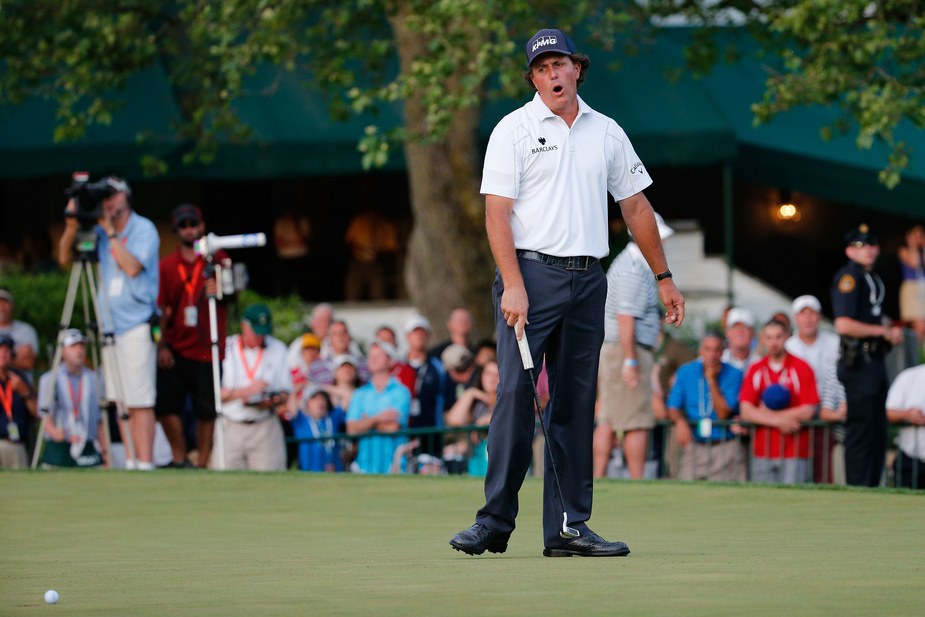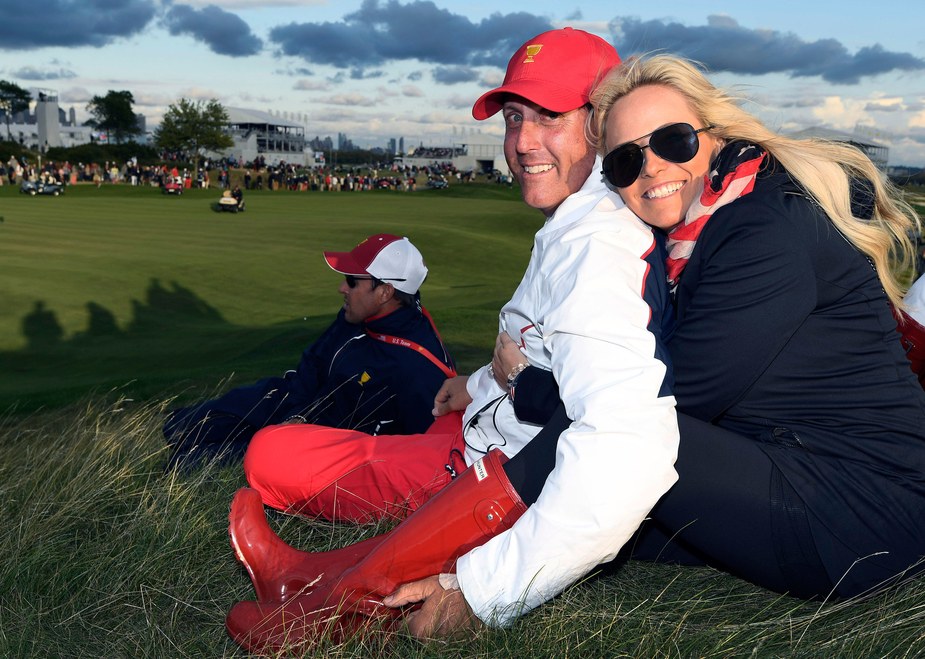The 47-year-old begins another season on the US PGA Tour certain of himself if uncertain of his golf future.
Take it from someone who never missed him in the media room: Phil Mickelson wants you to understand precisely what he’s saying. It’s an obsession with verbal clarity that borders on fetishistic, and it comes out in the carefully measured way he speaks – like an eminent professor in front of students who are bright, yes, but prone to laziness, prone to intellectual shortcuts in a world that demands rigour. His tone can sound almost artificial, but you quickly learn with Phil that it comes from a place of sincerity … misguided, almost delusional sincerity, but sincerity nonetheless.
When he over-enunciates each word in his slightly nasal tenor, cadence slow, emphasis thrown about liberally, it’s because he wants to convince you, and also himself, that there is order to the universe. Even when he jokes, it’s with a pedagogical intent – he is bullying you, in a friendly way, to help you reach a deeper understanding. And when he’s finished making his point, his eyes widen to impressive fullness, illuminated by a powerful wattage most commonly seen in cult leaders. He holds you in his gaze until you provide a gesture of acknowledgement. A nod will do. In fact, a nod is perfect – it’s not necessary for anyone but Phil to talk.
We’ll see all this again starting today at the CareerBuilder Challenge, a familiar place for the 47-year-old to begin his 2018 US PGA Tour season. He has played in Palm Springs 14 times in his two-decade career on tour, and won there twice.
Mickelson’s words are meant to be canonical from the moment they leave his mouth. He is not a great listener, but he is so smart and so talented that he doesn’t need to be. He will happily lift you up to his level, if you only recognise his authority and consent to learn at his feet. Cross the man – God forbid – and he will lay waste to you with an Olympian vengeance, of a kind that cannot be withstood even by a fellow god such as Tom Watson (may his reputation RIP).
Back to the word “delusion” – what gives?
I have a theory that Phil’s fixation on a logical worldview is self-administered bunkum. It’s snake oil that he sells to himself. In real life, Phil Mickelson rides the currents of chaos. At the heart of his existence is not symmetry or structure, but pure reckless anarchy played out on the tenuous foundation of a hunch, and it’s evident to anyone who has watched him play golf for more than two minutes.
(I’ve read before that he has a gambler’s soul, but that’s a euphemism. Phil is a literal gambler. Yes, he’s a metaphorical one on the golf course, but he’s an actual gambler in real life, so saying he has a gambler’s soul is a little like saying a Galapagos turtle has a Galapagos turtle’s soul.)
‘God bless him, Phil has never failed us. He was, and remains, a recurring meme that can’t disappoint. If I wake up this Saturday to find that he played his third shot at the 14th hole at La Quinta from the cockpit of the Goodyear Blimp, I wouldn’t be surprised.’
Phil surfs the choppy waves of entropy, and trusts his fate to the stars more than any athlete I’ve ever seen. So how else to read his dogmatic insistence on the clear explanation, the sensible conclusion, except as a desire to impose order on a life whose rhythms depend on quantum bursts of intuition? I think he knows deep down that chaos is his personal truth, but he retains enough sanity to want to deny it, to live in a world governed by reason, to cast himself as a conservative rather than a radical.
Let’s get concrete: in 2014 at the Wells Fargo tournament in Charlotte, I followed Phil and his former caddie Jim (Bones) Mackay for a few holes because I loved to hear them talk. I rarely understood what any of their chatter meant, mostly, because when you work together for decades, you develop a spoken shorthand that verges on unbreakable code. But I grasped the obsessive quality well enough – Phil’s neurotic need to account for every possible contingency before taking action, and Bones’ willingness to accommodate him. (I had never seen anything like it, nothing so thorough and crazy and brilliant, until I discovered a healthier version in Jordan Spieth and Michael Greller.)

It also had a performative quality. Mickelson’s playing partner that day was Kevin Kisner (years before they became comical US Presidents Cup dance partners), and Kisner was noticeably quiet around his legendary colleague, whispering when he was too close to the galleries. Not Phil – I would say he lacked self-consciousness, but that isn’t quite true. He seemed to actually enjoy the stage, as if he knew his conversation with Bones was just as much a part of the show as the shot that followed.
Anyway, I decided that day to write down what I heard. Here’s the conversation, as transcribed in my notes, from the sixth hole, starting with Bones:
“There’s a helping wind, right to left.”
“Can I leave it up there?”
“I do think you have to get a cut in.”
“Can’t have the same line.”
“If it’s doing something you don’t like, wait it out.”
“It’s not enough right now, is it?”
“Well, it’s the club…”
“It’s the club.”
“I’d like to get a little less.”
Phil hits.
“Darn it, same line as yesterday.”
It reads pretty ordinary, and it preceded a pretty ordinary shot on a long par 3. But how many times have we seen these same extensive, prepare-for-every-eventuality conversations precede a truly lunatic shot? A shot so ill-advised, and so improbable, that it looks like the gambler’s unique breed of self-sabotage?
And each time, after each crazy risk, Phil is able to rationalise it. There was always a good reason for the flop shot, the laser through the trees, the bank shot off a stone wall, the God-knows-what-next. Structure and logic prevail – he invents the explanation after the act.
It will be hard to describe Mickelson to future generations. The career stats outline his greatness well enough – five Majors, 42 US Tour wins, locker in the World Golf Hall of Fame – but they don’t explain everything. They don’t explain how one of the greatest golfers in history was never, by any metric, the greatest golfer in a single year. They don’t explain that it took him too long to win his first Major, and that for a while he didn’t play so well under pressure. They don’t explain that his early failures arose not because the moment was too big for him, but because he was too big for the moment – took too many risks, lacked the underlying caution and consistency that even dynamic champions like Tiger Woods possessed in the clutch. They don’t explain his talent for getting out of trouble, and how it was matched only by his talent for finding trouble in the first place (a talent, by the way, that transcended golf).
They don’t explain the US Open in 2013 at Merion – one of his six heartbreaking runner-up finishes in America’s national championship – when Phil needed to sink an impossible uphill 30-metre pitch to tie Justin Rose and force a playoff. They don’t explain the way he stalked the green, reading every hint of a break, utterly convinced that the miracle was imminent. More importantly, they don’t explain how he made us believe – how beyond the wins and losses, he seemed capable of golf voodoo, and how his persona was so magnetic that he could make us forget the odds. He missed that shot, of course, but it remains fascinating to me that standing behind him on the 18th fairway, I didn’t just think it was possible that he’d sink it. I thought it was likely.

And the stats don’t explain the desperate desire among fans, particularly from my generation, for a larger-than-life charismatic demigod to stand against the vanillionaire athlete – those lords of blandness who threaten to make this sport and all others extremely boring. God bless him, Phil never failed us. He was, and remains, a recurring meme that can’t disappoint. If I wake up this Saturday to find that he played his third shot at the 14th hole at La Quinta from the cockpit of the Goodyear Blimp, I wouldn’t be surprised. To fans like me, he represents lunacy, and his success from within that framework is even better than 14 Majors.
There are stories we’ll be able to tell about Phil, sure, like the time he bet $1,000 with a reluctant Nick Watney in a practice round at the British Open, and then made Watney pay £1,000 when he lost – “this is Britain”. We can tell about all the weird shots, the great victories, the tragic near-misses, or how he rescued the entire institution of the US Ryder Cup by throwing Tom Watson to the wolves.

But we should also tell the parts that aren’t perfectly constructed to turn the man into a capricious trickster god. About how every young player he took under his wing seemed to fizzle out in his shadow. About the times he risked too much, about the self-belief that was so all-encompassing, so manic, that it seemed to shatter him when he failed. About how when Phil flubbed an important shot, he didn’t just look disappointed – he looked shocked, even humiliated. He looked like a gambler who risked too much, got high on the possibilities, and suffered deeply in the comedown.
So, can Phil still make an impact in 2018, at the ripe old age of 47? It’s the question the golf world asks as Mickelson hopes to record his first victory since the 2013 British Open, cap the career Grand Slam at the US Open at Shinnecock Hills and help lift the US Ryder Cup team to a victory on foreign soil in September for the first time in 25 years. The answer is, I don’t know. When you live by chaos, you die by chaos, but then you can live by chaos again. I suspect there will be more than a few second acts in Phil’s American life – there have been one or two already – and any outcome this season will feel like the right one, as long as he lives large. On that front, I’m not especially worried.

